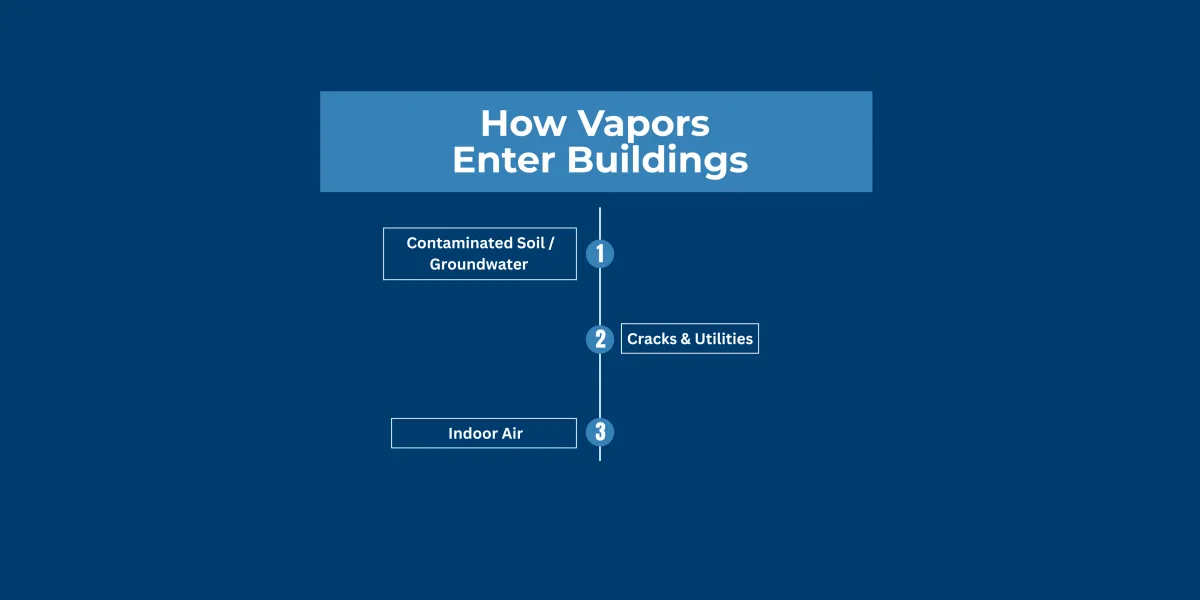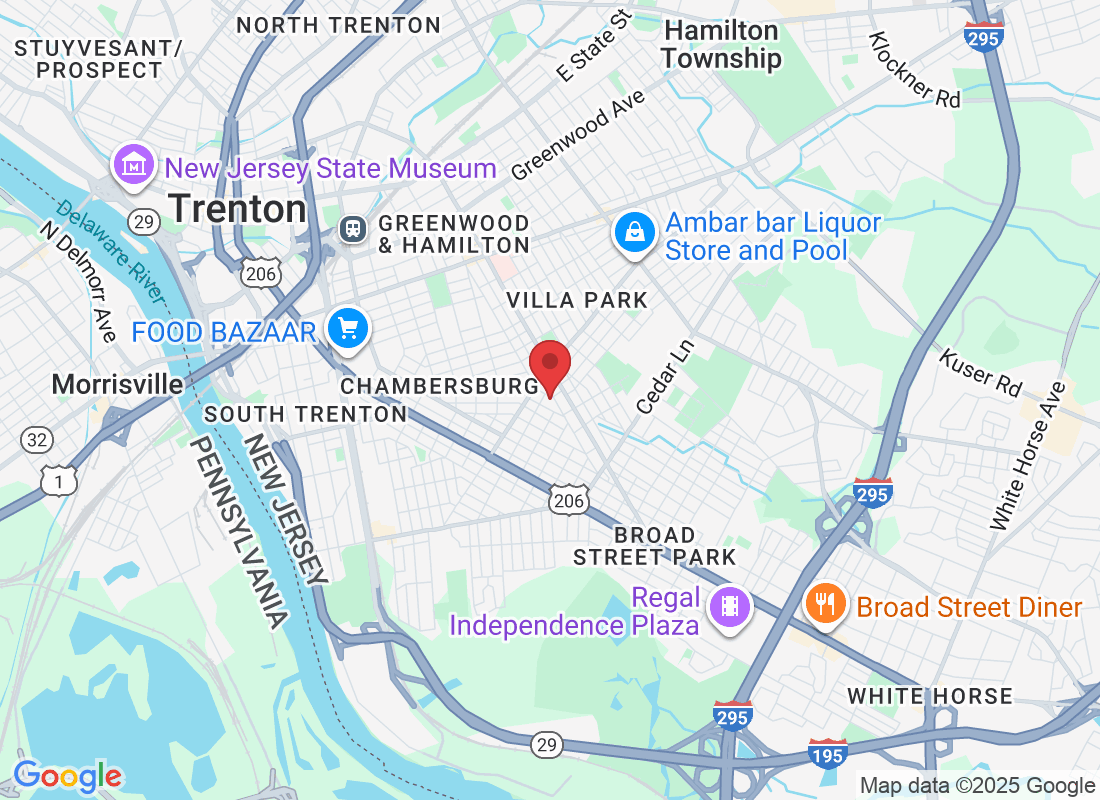
Vapor Intrusion FAQ
Vapor intrusion occurs when harmful vapors move from contaminated soil or groundwater into indoor air. Oak Environmental provides NJDEP-compliant vapor intrusion testing and mitigation to protect property owners, buyers, lenders, and developers.
What is vapor intrusion?
Vapor intrusion happens when harmful gases move from contaminated soil or water into the air inside a building.
Where do the vapors come from?
They usually come from spills or leaks—like from gas stations, dry cleaners, or old tanks—and move through the ground.
Is vapor intrusion dangerous?
Yes. Some vapors, like PCE, TCE, or gasoline compounds, can be harmful to people if they build up in indoor air.
How do I know if I have a vapor problem?
The only way to know for sure is to test the soil gas or indoor air. We install vapor points or use small air cans to check.
When do I need to test for vapor intrusion?
You may need testing if you're near a contaminated site, if your site has VOCs, or if NJDEP requires a vapor evaluation.
What is a Vapor Intrusion Pathway Evaluation?
It’s a process that reviews laboratory test results, building use, and soil data to see if vapors might enter the air inside.
What happens if vapors are found?
If the levels are too high, we help install a system—like a fan or vent—to keep the vapors from entering the building.
Can vapor intrusion delay my sale or project?
Yes. If vapor risks aren’t handled, it can hold up your deal. Testing and a plan help keep things on track.
Who needs to fix vapor issues—the seller or buyer?
It depends on the deal. But either way, we’ll give you the data, explain the risks, and help with the next steps.
Why choose Oak Environmental for vapor intrusion services?
We’re fast, experienced, and NJDEP-compliant. We help you test, fix, and move forward—without confusion or delay.
What is vapor intrusion?
Vapor intrusion is the movement of chemical vapors—such as petroleum compounds, perchloroethylene (PCE), or trichloroethylene (TCE)—from contaminated soil or groundwater into buildings through cracks, utility lines, or foundations.
Where do vapor intrusion risks come from?
Vapors usually originate from:
• Gasoline stations and petroleum releases
• Dry cleaners using solvents such as PCE
• Industrial spills or leaks
• Abandoned or leaking underground storage tanks
Is vapor intrusion dangerous?
Yes. Prolonged exposure to certain volatile organic compounds (VOCs) may increase health risks and create liability for property owners. NJDEP requires investigation when there is evidence of potential vapor intrusion.
How can I tell if my property has a vapor intrusion problem?
The only reliable method is environmental testing. Oak Environmental collects:
• Soil gas samples using subsurface vapor points
• Indoor air samples using certified sampling canisters
Results are analyzed by accredited laboratories and compared to NJDEP screening levels.
When is vapor intrusion testing required in New Jersey?
Testing is typically required when:
• A property is near a known contaminated site
• A Phase II ESA identifies VOCs in soil or groundwater
• NJDEP issues a directive for vapor intrusion evaluation
What is a Vapor Intrusion Pathway Evaluation?
A Vapor Intrusion Pathway Evaluation is the process of reviewing laboratory results, building use, and environmental data to determine whether vapors are entering indoor air. It is a required step in the NJDEP’s Site Remediation Program.
What happens if vapor intrusion is confirmed?
If elevated vapor levels are found, Oak Environmental designs and installs mitigation systems such as:
• Sub-slab depressurization systems (similar to radon systems)
• Ventilation systems to reduce indoor concentrations
• Ongoing monitoring to verify effectiveness
All work is completed to NJDEP standards to protect health and property value.
Can vapor intrusion delay a property sale or redevelopment project?
Yes. Lenders and attorneys often require documentation showing vapor intrusion has been tested and addressed. Without a mitigation plan or NJDEP-compliant evaluation, deals may stall or fall through. Oak Environmental provides lender-ready reports to keep transactions on track.
Who is responsible for addressing vapor intrusion—the buyer or seller?
Responsibility is typically negotiated during the transaction. However, either party must ensure compliance with NJDEP regulations. Oak Environmental provides clear data, risk explanation, and defensible reports to support negotiations.
Why choose Oak Environmental for vapor intrusion services?
Oak Environmental offers:
• Licensed professionals with decades of NJDEP compliance experience
• Fast, accurate testing and reporting
• Defensible reports accepted by lenders, attorneys, and regulators
• Clear guidance to protect property value and client interests
Our mission: Safe. Compliant. Clear.

Process Flow
Investigation
Testing
Mitigation
NJDEP Approval
5 Things Every NJ Property Buyer Should Know About Oil Tanks
Protect your deal and your budget.
Get our free 2-page guide to NJ tank issues before you commit.
Contact Us
Ready to Solve It?
Let’s Talk.
Safe. Simple. Compliant.
We Help You Solve Environmental Problems
At Oak Environmental, we check properties for problems and help clean them up. We make sure everything follows the rules. You’ll get clear answers, fast help, and no surprises.
127 Vroom St, Trenton, NJ 08610
551-525-3211

Serving all of New Jersey with fast, expert environmental due diligence, investigations, and remediations.
Clear answers. Strong protection. Real results.
Quick Links
Support
Copyright 2025. Oak Environmental Consulting and Services. All Rights Reserved.

